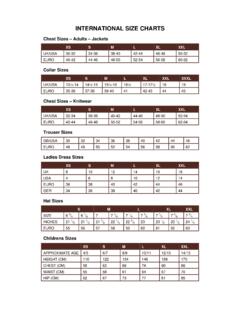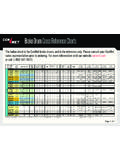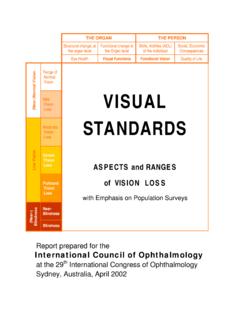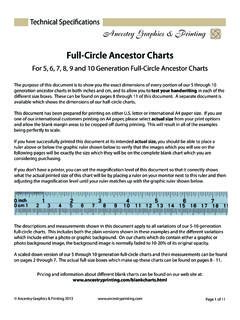Transcription of Use of World Health Organization and CDC Growth …
1 Please note: An erratum has been published for this issue. To view the erratum, please click here. Morbidity and Mortality Weekly Report Recommendations and Reports September 10, 2010 / Vol. 59 / No. RR-9. Use of World Health Organization and CDC Growth Charts for Children Aged 0 59 Months in the United States department of Health and human services Centers for Disease Control and Prevention MMWR Contents The MMWR series of publications is published by the Office of Surveillance, Epidemiology, and Laboratory Services, Centers for 1. Disease Control and Prevention (CDC), Department of Health 1. and Human Services, Atlanta, GA 30333. Suggested Citation: Centers for Disease Control and Prevention. Creation of the WHO and CDC Growth 2. [Title]. MMWR 2010;59(No.)
2 RR-9):[inclusive page numbers]. Rationale for 6. 9. Centers for Disease Control and Prevention Use of Recommended Growth Charts in Clinical 11. Thomas R. Frieden, MD, MPH. Director Recent WHO Growth chart Policies and 12. Harold W. Jaffe, MD, MA 13. Associate Director for Science 13. James W. Stephens, PhD. Office of the Associate Director for Science Stephen B. Thacker, MD, MSc Deputy Director for Surveillance, Epidemiology, and Laboratory Services Editorial and Production Staff Christine G. Casey, MD. (Acting) Editor, MMWR Series Teresa F. Rutledge Managing Editor, MMWR Series David C. Johnson Lead Technical Writer-Editor Catherine B. Lansdowne, MS. Project Editor Martha F. Boyd Lead Visual Information Specialist Malbea A. LaPete Stephen R. Spriggs Terraye M.
3 Starr Visual Information Specialists Quang M. Doan, MBA. Phyllis H. King Information Technology Specialists Editorial Board William L. Roper, MD, MPH, Chapel Hill, NC, Chairman Virginia A. Caine, MD, Indianapolis, IN. Jonathan E. Fielding, MD, MPH, MBA, Los Angeles, CA. David W. Fleming, MD, Seattle, WA. William E. Halperin, MD, DrPH, MPH, Newark, NJ. King K. Holmes, MD, PhD, Seattle, WA. Deborah Holtzman, PhD, Atlanta, GA. John K. Iglehart, Bethesda, MD. Dennis G. Maki, MD, Madison, WI. Patricia Quinlisk, MD, MPH, Des Moines, IA. Patrick L. Remington, MD, MPH, Madison, WI. Barbara K. Rimer, DrPH, Chapel Hill, NC. John V. Rullan, MD, MPH, San Juan, PR. William Schaffner, MD, Nashville, TN. Anne Schuchat, MD, Atlanta, GA. Dixie E. Snider, MD, MPH, Atlanta, GA.
4 John W. Ward, MD, Atlanta, GA. Vol. 59 / RR-9 Recommendations and Reports 1. Use of World Health Organization and CDC Growth Charts for Children Aged 0 59 Months in the United States Prepared by Laurence M. Grummer-Strawn, PhD1. Chris Reinold, PhD1. Nancy F. Krebs, MD2. 1 Division of Nutrition, Physical Activity, and Obesity, National Center for Chronic Disease Prevention and Health Promotion 2 Department of Pediatrics, University of Colorado Denver Summary In April 2006, the World Health Organization (WHO) released new international Growth charts for children aged 0 59 months. Similar to the 2000 CDC Growth charts, these charts describe weight for age, length (or stature) for age, weight for length (or stature), and body mass index for age. Whereas the WHO charts are Growth standards, describing the Growth of healthy children in optimal conditions, the CDC charts are a Growth reference, describing how certain children grew in a particular place and time.
5 However, in practice, clinicians use Growth charts as standards rather than references. In 2006, CDC, the National Institutes of Health , and the American Academy of Pediatrics convened an expert panel to review scientific evidence and discuss the potential use of the new WHO Growth charts in clinical settings in the United States. On the basis of input from this expert panel, CDC recommends that clinicians in the United States use the 2006 WHO international Growth charts, rather than the CDC Growth charts, for children aged <24 months (available at ). The CDC Growth charts should continue to be used for the assessment of Growth in persons aged 2 19 years. The recommendation to use the 2006 WHO international Growth charts for children aged <24 months is based on several considerations, including the recognition that breastfeeding is the recommended standard for infant feeding.
6 In the WHO charts, the healthy breastfed infant is intended to be the standard against which all other infants are compared; 100% of the reference population of infants were breastfed for 12 months and were predominantly breastfed for at least 4 months. When using the WHO Growth charts to screen for possible abnormal or unhealthy Growth , use of the and percentiles (or 2 standard deviations) are recommended, rather than the 5th and 95th percentiles. Clinicians should be aware that fewer children will be identified as underweight using the WHO charts, slower Growth among breastfed infants during ages 3 18 months is normal, and gaining weight more rapidly than is indicated on the WHO charts might signal early signs of overweight. Introduction (4,5), these Growth charts describe weight for age, length (or stature) for age, weight for length (or stature), and body mass The physical Growth of infants and children has long been index (BMI) for age.
7 WHO Growth curves include BMI for age recognized as an important indicator of Health and wellness starting at birth, and CDC Growth curves include BMI for age (1,2). Growth charts have been used for at least a century beginning at age 2 years. CDC and WHO Growth charts also to assess whether a child is receiving adequate nutrition and include a curve for head circumference for age; CDC provides to screen for potentially inadequate Growth that might be values for children aged <36 months, and WHO charts include indicative of adverse Health conditions. Traditionally, atten- a head circumference curve for those aged <60 months. tion has focused on undernutrition. However, in the past few Because two sets of Growth curves exist for assessing child decades, concerns about excessive weight gain have increased, Growth , clinicians in the United States need guidelines indicat- and Growth charts have been used to screen for overweight, ing which curves should be used and for which children.
8 This including obesity. report provides guidance on the use of the WHO and CDC. In April 2006, the World Health Organization (WHO). Growth charts and is intended for Health -care providers and released a new international Growth standard for children aged others who measure and assess child Growth . 0 59 months (3). Similar to the 2000 CDC Growth reference Corresponding preparer: Laurence M. Grummer-Strawn, CDC, 4770 Methods Buford Highway, MS K-25, Atlanta, GA 30341. Telephone: 770-488- 5702; Fax: 770-488-5369; E-mail: The material in this During June 29 30, 2006, CDC, the National Institutes of report originated in the National Center for Chronic Disease Prevention Health (NIH), and the American Academy of Pediatrics (AAP). and Health Promotion, Ursula Bauer, PhD, Director.
9 Convened a meeting in Hyattsville, Maryland, to review scien- 2 MMWR September 10, 2010. tific evidence and obtain opinions regarding the use of the new WHO then recommended that these z scores be used as a global WHO Growth charts in clinical settings in the United States. reference for the definition of malnutrition. The curves began The participants at the meeting were selected on the basis of to be used worldwide. their expertise in child Growth , statistical methodology, clini- In spite of their widespread use, there were numerous con- cal application, and maternal and child Health policy. CDC, cerns about these charts, including a lack of racial diversity in NIH, and AAP each had numerous representatives; additional the infant sample, an infant sample composed of infants who experts from academia, clinical professional groups, and other were almost all formula fed, and the disjunction in length and government agencies were invited.
10 Stature measurements when transitioning from the charts for Participants were provided background documents describ- younger children to those for older children. Therefore, while ing the development of both sets of curves. At the meeting, planning the third National Health and Nutrition Examination CDC made presentations on the methods used to create the Survey (NHANES III), NCHS decided to oversample children CDC Growth charts, and a principal investigator for the WHO aged <6 years so that the 1970s Growth charts could be revised. Multicentre Growth Reference Study (MGRS), which gener- After data collection was completed in 1994, CDC began ated the data used for the WHO Growth curves, made a presen- revising the curves, and the new charts were released in 2000.
















